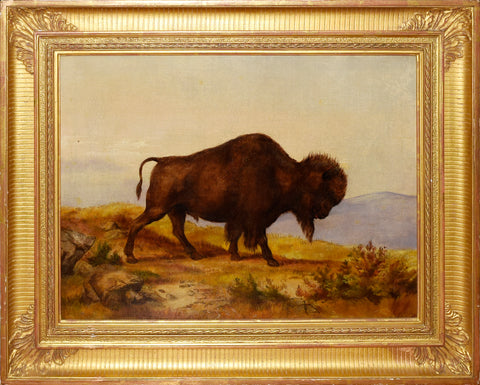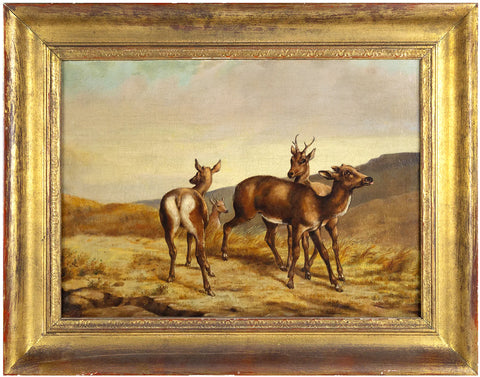
Francis Augustus Silva, Seabright from Galilee, New Jersey
FRANCIS AUGUSTUS SILVA (American, 1835-1886)
Seabright from Galilee, New Jersey
Oil on canvas: 21" x 42";
Frame: modern; 32 ¾" x 54”
Signed and dated lower right: "1880 Seabright from Galilee/ Francis A. Silva"
1880
Frame: Contemporary wood and compo frame with hand-applied gesso and 22K gold leaf; an excellent reproduction nineteenth-century frame.
This evocative landscape is the work of prominent nineteenth-century American painter Francis Augustus Silva. The scene shows the coastal town of Sea Bright, New Jersey, as glimpsed from the small town of Galilee, which lies on the spit of land -- now Monmouth Beach - that separates the Shrewsbury River from the Atlantic. This part of the northern New Jersey shore is now highly developed, but Silva shows it as a sleepy, bucolic seaside community.
In the distance, the village of Sea Bright appears on the low horizon as a cluster of clapboard houses rising beyond the inlet formed by the calm, marshy waters of the Shrewsbury River. At far left is Rumson, and behind that the Highlands of Navesink. In the foreground, a small girl feeds a group of chickens in a grassy boat- yard. The quality of the light -- redolent of a still, warm spring morning -- grants the composition a heightened sense of naturalism and tranquility. This masterful treatment of light is the hallmark of Silva's style. The artist, known for exaggerating and intensifying natural effects of light and air for poetic purposes, is considered a leader in the American Luminist movement. His subtle manipulation of light and atmosphere was an aesthetic device that tran- scended naturalism and became an almost abstract means of expressing sentiment.
Silva was born on October 4, 1835 in New York City, the son of a French-Portuguese barber and his wife. Silva was apparently a precocious talent: as a boy, he exhibited pen drawings at the American Institute. Silva's parents, however, did not want him to pursue art as a career, so he apprenticed in several trades before ending up in the workshop of a sign painter. He practiced this trade, which involved painting historical subjects on the wooden panels of vehicles such as stage coaches and fire engines, until the outbreak of the Civil War in 1861, when he signed on to serve in the Seventh Regiment of the New York State Militia.
Silva's debut as a painter came soon after the end of the war, at the National Academy of Design's annual exhibition of 1868-1869. Thereafter, his rep- utation as a marine and landscape painter grew rapidly. In addition to the National Academy of Design, Silva exhibited at the Brooklyn Art Association and the Union League Club. Many of his early works focused on the Hudson River or the New England shoreline, but not long after marrying Margaret A. Watts of Keyport, New Jersey, Silva turned his attention to the sand dunes and barrier islands of the New Jersey shore.
By 1870, Silva had evolved from a self-taught artist to one with a remarkably skillful technique and a reper- toire of marine subjects and atmospheric effects that varied little for the rest of his life. "We have few artists who are so accurate in drawing or so conscientious in the rendering of detail," an Art Journal critic wrote in 1880: the very year Silva completed this superb composition. Silva's luminous technique led to his election to the American Water Color Society in 1872. The artist died relatively young -- at the age of fifty -- on March 31, 1886. His works are well represented in highly important American collections, including the National Gallery of Art in Washington, D.C., the Peabody Essex Museum in Salem, Massachusetts, and the Brooklyn Museum of Art in New York. This is a lovely work by an important American master.
We Also Recommend





![François-Auguste Biard (French, 1798-1882), Shipwreck... [View taken in Magdalena-Bay (Spitzbergen)]](http://aradergalleries.com/cdn/shop/products/biard_magdalena_painting_large.jpg?v=1517518971)